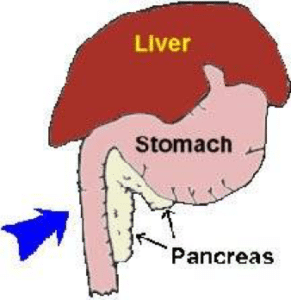What is Diabetes Mellitus?
In order to understand what diabetes is, it is necessary to understand a little bit about how the body works.
The pancreas is an organ that sits between the stomach and the small intestines. It secretes a hormone called insulin. Insulin is the hormone that regulates the body’s blood sugar. The cells of the body require sugar to function. The sugar, which comes primarily from the food we eat, travels through the blood stream and is distributed to the cells of the body. The cells require insulin from the pancreas to absorb sugar. Insulin is like a key that opens the door to the cell allowing sugar in. Diabetes occurs when an animal stops producing insulin.
When the sugar cannot be absorbed into the cells they send out signals to the body demanding sugar. Those signals fool the body into thinking it is starving. Yet all along there is plenty of sugar in the bloodstream it just can’t be absorbed. As a result, the body enters a state a lot like starvation.
During starvation, the body’s proteins and fat break down and are converted into sugar. After this happens there are excessive amounts of sugar in the bloodstream. Unfortunately, without insulin, none of this sugar can be utilized and the whole process continues until the animal is very sick.
The Main Symptoms of Diabetes Mellitus Are:
Excessive Eating- The animal feels like it is starving.
Excessive Urination- The animal urinates a lot because the excessive blood sugar dumps into the urine and draws fluid with it causing much more urine to be produced.
Excessive Drinking- The animal is thirsty because it’s urinating so much.
Weight Loss – The animal breaks down it’s body tissues to make more sugar, none of which can be utilized.
Urinary Tract Infections- All the sugar in the urine makes the bladder an incubator for bacteria.
Cataract Formation in Dogs- Later in the disease process, sugar that is drawn into the lens causes cataracts
How is Diabetes Diagnosed?
Usually the diagnosis is made from a combination of the history and tests showing dramatic glucose elevations in the blood and urine sugar. Some pets are able to substantially raise their blood sugars from stress (such as might occur when a sensitive, sick, and anxious patient goes the vet’s office). This could create misleading test results. If there is any question about the diagnosis, a test called a fructosamine level may be requested. This test gives an indication of how the blood sugar levels have been over the past several weeks. When the fructosamine is high, the patient has had persistent elevations of their blood sugar helping to diagnose diabetes. The fructosamine test is also sometimes used in monitoring therapy for diabetes mellitus.
How can We Prevent Diabetes?
Like people, obesity is a major factor in increasing your pet’s risk for developing diabetes.
However, there is also a genetic predisposition in some dogs and cats. Keeping your pets at their appropriate weight is essential to prevent diabetes in those pets with no genetic predisposition.
How is Diabetes Treated?
While diabetes cannot be cured, it is a disease that can be successfully managed. Treatment includes a combination of insulin and diet changes. Most pets require lifelong treatment and monitoring.
If you are concerned about recent changes in your pet’s appetite, urinary behavior, or recent weight loss, we recommend a physical exam. The veterinarian can assess your pet’s overall health and determine if any testing is recommended at that time.
Annual Dental
Oral care is very important for diabetic pets. An infection in the mouth can make it hard to regulate a diabetic. Regular dental care is essential to control diabetes. Also, bacteria from the mouth can seed the body with bacteria and when blood sugar levels run high, infections in important organs can take root. The kidneys and heart are particularly vulnerable.
What’s the Good News?
Diabetes can be treated and pets can live a happy and comfortable life when their diabetes is well regulated
Tommy
Dr. Shapiro’s cat Tommy was diagnosed with Diabetes at 12 years of age. He lived until he was 16 years old.



